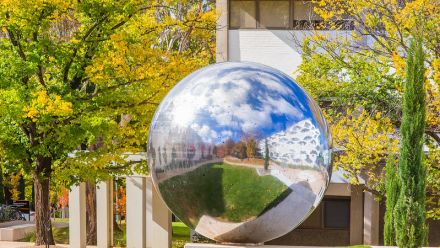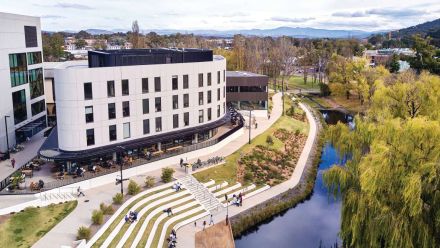Opera’s digital renaissance
Opera is increasingly looking towards digital staging to broaden its appeal to audiences and as a way to modernise the art form and the School of Music is excited to be at the forefront of this trend
A collaboration between three seemingly diverse areas of ANU took the world's oldest opera L'Orfeointo the digital age. NATASSJA HOOGSTAD HAY reports for ANU Reporter.
From Vivid to Enlighten, sophisticated digital projections are becoming a mainstay on the festival circuit. Now opera, one of the oldest forms of musical theatre, is embracing digital technology and using immersive digital projections as a way to provide an entirely new theatre experience.
In a collaboration that spanned the ANU School of Music, School of Art and the Research School of Astrophysics and Astronomy, Llewellyn Hall was transformed into a fully digital set in an opera for the 21st century as L'Orfeo lit up the stage.
The collaboration included a star map from the Research School of Astrophysics and Astronomy providing the backdrop for the final scene, while the ANU School of Art designed costumes for the show and provided extra projections on performance to add to the ambiance.
L'Orfeo, by the 17th century Italian composer and singer Claudio Monteverdi, tells the story of the Greek legend of the musician Orpheus and his attempt to bring his bride Eurydice back from the dead. It is oldest opera still in the repertoire today. While the myth itself has its roots deep in Greek antiquity, it was Monteverdi who brought the story to life through his ground-breaking opera.
To bring the renaissance opera into the 21st century, School of Music Head of School Peter Tregear enlisted experts Andrew Quinn, for the digital set design, and Alessandro Chiodo for the lighting. Both based in Milan, the pair has worked together on many live performances and both have backgrounds in film production.
Quinn worked on special effects for films like the Matrix and Tomb Raider and recently become involved in live stage productions.
"L'Orfeo started a wave of musical theatre that became quite high tech for the time," Quinn says.
"The inspiration for the digital sets was the opera itself, but I also wanted to keep the content quite a mechanical but antique feel in keeping with its history."
Almost all the initial lighting and set design was done via file exchange over the internet, with Quinn and Chiodo arriving in Canberra just over a week before the performances.
Throughout the whole production, which occurred in August, the School of Music sought to experiment with this new way of presenting opera. The trend in using digital staging has been made possible thanks recent leaps and bounds in video technology.
"This is the first performance at Llewellyn Hall to use a fully digital set," Tregear says.
"Opera is increasingly looking towards digital staging to broaden its appeal to audiences and as a way to modernise the art form, and the School of Music is excited to be at the forefront of this trend."
The School of Music stages an opera every two years, and L'Orfeo was an "obvious choice" for this year's performance, according to Tregear.
"L'Orfeo has many roles suitable for young voices and is in and of itself a major historical landmark of Western art. It is a work that praises the centrality of music itself in our lives," he says.
"In the planning stages, I was intrigued to hear that Llewellyn Hall had never been used to stage an opera and mused on what it might take to make it work effectively as an opera theatre. Lacking a 'fly tower' via which one can drop in a set, the hall nevertheless seemed very suited for digital projection. It was then a matter of finding a digital artist prepared to work on the sets."
In addition to its international talent, including distinguished British tenor Nicholas Mulroy, staff and students from the School of Music featured on stage, in the orchestra and in the production of the show. In the director's chair was local Canberra theatre veteran Cate Clelland. All up, 76 performers were involved, including 30 musicians, 35 members of the chorus and 11 principals.
The score was a version that stayed as close as possible to the original 17th century original, with a number of exotic instruments featuring the orchestra including a regale, cornets, sackbutts and theorbos.
For the performances, 15-metre by 10-metre semi-transparent screen was installed along with a high-powered digital projector. A total of 75 metres of programmable LED lights and 16 moving remote lights were also deployed. From the most joyous wedding scene to the dark depths of the underworld, the digital projections conveyed the scene.
Orpheus himself is a major figure in classical mythology. He is the figure who unites art and science, and is also considered to be the founder of religion.
L'Orfeo spurred a new wave innovation in theatre in the 17th century. Now the opera is once again at the forefront of new innovation.
Download the free ANU Reporter tablet app to watch interviews with L'Orfeo performers.
Each new edition will automatically download to your Newsstand.
Don’t have a tablet?
Subscribe to receive the next print edition of ANU Reporter.


